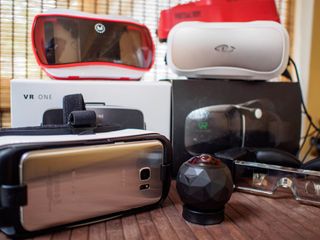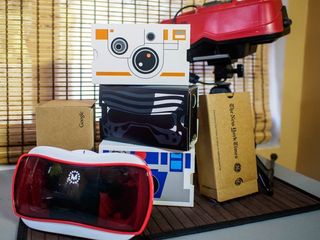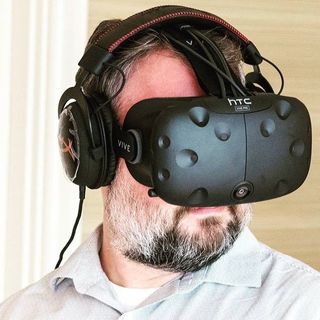The massive cloud of things we call VR is here to stay

There are three kinds of people when it comes to the current wave of virtual reality. You've got the early adopters who are all about throwing down money on one of this generation's VR helmets, curious techies who are waiting to see if any of this sticks before putting money down, and the rest of the world. Much like previous iterations of VR, that third group either has no idea what VR is or only knows about it because Lil Wayne and William H. Macy keep showing up on their TV wearing one.
A casual observer may look at the new world of VR hardware that has exploded over the last year and shrug it off as something that will never reach "mainstream consumers" with the current pricing and availability. It seems more likely that those casual observers aren't looking at the whole picture. VR is absolutely here to stay, because it is significantly more than just hardware you strap to your head now.
VR content is everywhere, and everyone loves it

Looking at VR as just hardware you wear ignores all of the cross sections, and that's where things are becoming truly important. While most of the VR gaming experiences require a headset and some kind on interactive setup, the passive experiences can be enjoyed in several key ways. What we once viewed as a unique experience crafted by Motorola in its Spotlight Stories can now be enjoyed on YouTube and Facebook with little more than an app on your phone or a browser on your PC. Go find any 360-degree video on Facebook and the initial reactions from folks who have never seen this kind of thing before are basically looking at magic. Content creators and advertisers are diving into ways to capture your attention with this video format, and it's working.
It couldn't be more clear that there's a lot more to VR right now than the hardware.
Consuming this content is only part of the equation. The real fun is in capturing it. Google's early efforts with photospheres and the ease with which you can upload 360-degree video to YouTube has created a space for all kinds of users to think about ways to enjoy capturing these experiences themselves. This time last year, that meant a lot of money and a lot of experience editing video to make it work well, and in that short time we now have $200 options with quality that comes dangerously close to the professional experiences we've seen come to Google Cardboard and the Gear VR recently. Unlike action cams, which are only different from the camera in your phone when you're flying down a snow-covered hill at 30 mph, 360 cams are perfect for anyone who sees anything cool, and wants to capture the whole moment instead of just a window into it.
With the recent push from Google making it easier to embed these 360 photos and videos into websites and apps, a set of tools they call VR View, it couldn't be more clear that there's a lot more to VR right now than the hardware. The content surrounding these experiences is what's really important, and that content is getting cheaper to capture and easier to share on an almost daily basis. This is an enormous amount of VR-ready photos and videos that don't require a headset to enjoy, complete with the knowledge that a VR component will take this cool experience and make you feel like you're there as the photos and videos are being captured.
Hardware variety can't be ignored

Previous generations of VR experiences were basically impossible to install in your home. They were prohibitively expensive, required a lot of space in your home to function well, and a lot of folks had some fairly significant problems with nausea and headaches after using them for more than a few minutes. This new generation of VR experiences offer quite a bit of variety. Google Cardboard works on just about everything, and can be used anywhere to get a more immersive feel from a 360 degree video. Samsung's Gear VR requires a Samsung phone, but there are quite a few of those in the world today, and the platform has grown at a remarkable pace to include great games and quality video.
This isn't an accessory to an existing market, this is creating a new market for users looking for new experiences.
Stepping up from that portable experience is Sony, which announced a VR headset more expensive than the game console required to power it. PlayStation VR appeals directly to the PlayStation 4 owners of the world, of which there are many. As the most popular console of this current generation of game consoles by a considerable margin, Sony has a massive user base to sell this headset to and a significant list of game publishers willing to support it out of the box. While this setup certainly isn't cheap by any means, it can be used in the living room or bedroom with ease and can be easily put away when finished.
Be an expert in 5 minutes
Get the latest news from Android Central, your trusted companion in the world of Android
Where things get a little less portable and universal is the desktop-class VR experiences. Oculus and HTC have built incredible, future-forward experiences that require a considerably powerful — and also expensive — desktop PC. In a world where portability is king and the traditional Windows-based PC is slowly losing marketshare to iPads and Chromebooks, the number of people in that vague "average consumer" bracket with a powerful gaming PC is dwindling. On the other hand, in a world of overpriced console ports and a lackluster list of exclusive titles, there hasn't been a huge reason to build a nice gaming PC in recent years until the Rift and Vive.
While the Oculus Rift and HTC Vive aren't inexpensive or simple, they are absolutely consumer-ready. Much in the same way that a new Pokemon game sells Nintendo 3DS handhelds and a new Halo game sells Xbox consoles, the HTC Vive and Oculus Rift are selling gaming PCs. This isn't an accessory to an existing market, this is creating a new market for users looking for new experiences. This isn't going to be a big dramatic shift in how the world uses computers, and it's not trying to breathe life into anything that was already deflating. Desktop-class VR is pushing forward, and the people who choose to be a part of that are doing so because it's something new.
'But my thing isn't supported so this other thing is going to fail.'

The bottom line is this — VR isn't going anywhere anytime soon. It's not going to fall flat like 3D content did, because actual people can easily and inexpensively make their own VR photos and videos. It's not limited to expensive PCs, and most of these experiences require the same amount of room in your home that you're already dedicating to watching television or playing games every day.
What happens next isn't about adoption, because on some level that has already happened.
VR isn't one thing right now, and that's significant for a couple of reasons. No one company is big enough to kill VR by failing in some spectacular fashion, and there are new ideas hitting each of these platforms every day. We're seeing VR used in schools, in homes, on the train to work (seriously, please don't do this), and very soon on vacations and even just out to lunch.
This thing we call VR right now is a giant changing mass of ideas and products and experiences, and it doesn't matter if your phones isn't supported or your brand of choice doesn't have a competing product out. This is ground zero for the new thing we call VR, and it's already everywhere. What happens next isn't about adoption, because on some level that has already happened.

